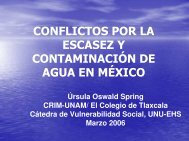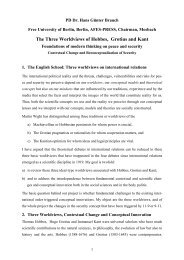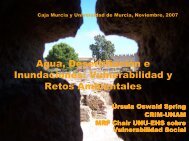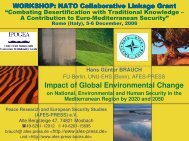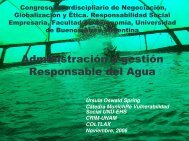Opening powerpoint presentation by H.G. Brauch, 21 November 2005
Opening powerpoint presentation by H.G. Brauch, 21 November 2005
Opening powerpoint presentation by H.G. Brauch, 21 November 2005
- No tags were found...
Create successful ePaper yourself
Turn your PDF publications into a flip-book with our unique Google optimized e-Paper software.
15424 HS: SectorialisingSecurity in the <strong>21</strong>st CenturyEnvironmental, Energy, Water, Food, Livelihood,Gender Security: State vs Human SecurityWS <strong>2005</strong>/2006©Hans Günter <strong>Brauch</strong>http://www.afes-press.de/html/download_hgb.htmlFU Berlin, Otto-Suhr-Institut fürPolitikwissenschaft
Security is a basic value, goal and means of politics.Security is always subjective, it depends on the perception ofdangers (threats, challenges, vulnerabilities & risks).The Fall of the Berlin Wall was instrumental for a reconceptualisationof security in politics and research.New security dangers (threats, challenges, vulnerabilities &risks) and security concepts have since influenced thedebate.Since the 1990s concepts of national security have beencomplemented with concepts of human security (UNDP1994).Different worldviews and mindsets have contributed since2001 to different security concepts and perceptions ofsecurity dangers in Europe and in the U.S.
Definition of security: concept, value, goal, means?2. Concept innovation <strong>by</strong> Context change: “Reconceptualis.”3. “Widening, Deepening, Narrowing” and “Sectorialisation”4. Model of Global Environmental Change and SecurityConcepts5. Causes of GEC: Climate change, desertification and consequencesGEC: hazards, migration, crises, conflicts.6. Change in reference objects: national & human security7. Spatial context: global, regional, national, societal security.8. Security concepts & security systems at the UN levels9. Security concepts at the EU level10. Goal of the Dialogue projec: “Reconceptualising Security”
1. Defining Security: term,concept, value, goal, means?A term: Security (lat.: securusand se cura; it. sicurezza, fr.:sécurité, sp.: seguridad, p.:segurança, g: Sicherheit)Security was introduced <strong>by</strong> Ciceroand Lucretius referring to a philosophicaland psychologicalstatus of mind.It was used as a political conceptin context of ‘Pax Romana’.Today ‘security’ as a political valuehas no independent meaning &is related to individual or societalvalue systems (<strong>Brauch</strong> 2003).A scientific conceptAs a social science concept,“security is ambiguous and elasticin its meaning” Art (1993)‘Security’: refers to frameworks,dimensions, individuals, issue areas,societal conventions & changinghistorical conditions &circumstances.Needed: Logical stringency.A political conceptTool to legitimate public funding foran accepted purpose: safety, protection(military & police)Political acceptability (support)gaining and regaining power.
1.1. Defining Security:Science vs. Object of AnalysisHumanities & SocialSciences:- Philosophy- International Law- Sociology, Economics- Geography- Political SciencePolitical Science- Political philosophy (ideas)- Government system &comparative government- International relations- Adminsitrative & policy sciences„Politik, politique“ ofPolitical SciencePolity: Legal Basis &Institutions- Foundations & Structures.- Legal (UN Charter, NATO, EU treaties- Institutions: UNSC, EU CommissionPolitics: Process- UN Security Council. NATO Council- Domestic: government vs. ParliamentPolicy: Field-> Security Policy- Actor specific: governments, Parliaments,parties, NGOs
1.2. A Classical Definition in PoliticalScience & International Relations Arnold Wolfers (1962), US of Swiss origin, realistpointed to two sides of the security concept: “Security, in an objective sense, measures the absenceof threats to acquired values, in a subjective sense, theabsence of fear that such values will be attacked”. Absence of “threats”: interest of policy-makers Absence of “fears”: interest of social scientists, especiallyof contructivists: “Reality is socially constructed” Iraq case: WMD: “subject. fear” vs. “lack of obj. threat” According to Møller (2003) Wolfer’s definition ignores:Whose values might be threatened? Which are thesevalues? Who might threaten them? By which means?Whose fears should count? How might one distinguishbetween sincere fears and faked ones?
1.4. Security Perception:Worldviews and Mind-sets Perceptions of security threats, challenges, vulnerabilities, risksdepend on worldviews of analyst & mind-set of policy-maker. Mind-set (Ken Booth): have often distorted perception of newchallenges: include ethnocentrism, realism, ideological fundamentalism,strategic reductionism Booth: Mind-sets freeze international relations into crudeimages, portray its processes as mechanistic responses ofpower and characterise other nations as stereotypes. Old Cold War mind-sets have survived global turn of 1989/1990 3 worldviews are distinguished <strong>by</strong> the English school: Hobbesian pessimism (realism) Kantian optimism (idealism) where international law and human rightsare crucial; and Grotian pragma-tism where cooperation is vital
1.5. English School: Hobbes, Grotius & KantHobbes (1588-1679) Grotius (1583-1645) Kant (1724-1804)Security perceptions depend on worldviews or traditions Hobbessian pessimist: power is the key category (narrow concept) Grotian pragmatist: cooperation is vital (wide security concept) Kantian optimist: international law and human rights are crucial
1.6. Robert Kagan*): Mars vs. Venus orUnited States vs. Europe (2003)On questions of powerAmerican and Europeanperspectives are diverging.Europe lives in a world of laws,paradise of peace & prosperityAmericans exercise power in ananarchic Hobbesian world wheredefence depends on militarymight.Americans are from MarsEuropeans from Venus I am neither from Mars nor Venusbut influenced <strong>by</strong> the English School* Of Paradise and Power(New York: Alfred A. Knopf, 2003)
1.7. Concepts of security in relation with peace,environment and developmentPillars & linkage concepts within the quartetIR research programsPeace ResearchSecurity StudiesDevelopment StudiesEnvironment Studies4 conceptual pillars I: Security dilemma II:Survival dilemma III: Sust. developm. IV: Sustain. peaceConceptual QuartetPeace Security•••I: Security dilemma•• IV II••Developm. Environm.III: SustainabledevelopmentConceptual Linkages•Policy use of concepts &Theoretical debates onsix dyadic linkages•L1: Peace & security•L 2: Peace & development•L 3: Peace & environment•L 4: Developm. & security•L 5: Devel. & environment•L 6: Security & environm.[six chapters reviewing &assessing the debates]
1.8. Questions for any Security ConceptFrom a minimalist security definition: “low probability ofdamage to acquired values”, Baldwin (1997) raised sevenquestions to be addressed <strong>by</strong> each security concept:o Security for whom? Security for which values?o How much security? From what threats? By what means?o At what cost? In what time?Møller (2003) argued that Wolfer’s definition ignores:o Whose values might be threatened? Which are these values?o Who might threaten them? By which means? Whose fears should count?o How might one distinguish between sincere fears and faked ones?Hintermeier (‘06) has focused on 4 conceptual questions of:o Security for whom and what?o Security for which values?o Security from whom or what?o Security <strong>by</strong> what means and strategies?
1.9. Conceptual Linkages:old: peace & security (UN Charter)new: security & environment & developmentMain goal of UN-Charter: Art. 1.1.„to maintain international peace and security, andto that end: to take effective collective measures forthe prevention and removal of threats to the peace,and for the suppression of acts of aggression or otherbreaches of the peace“.Development and environment concepts and policiesdeveloped later, as did linkage concepts of environment& security or environmental security
1.10. New Linkages: 11th EADIInsecurity & DevelopmentUNDP: Human Development Report of 1994: conceptof human security as a comprehensive concept.Focus of 11th EADI Conference <strong>21</strong>-24 September<strong>2005</strong> in Bonn: http://eadi.org/gc<strong>2005</strong>/No human development without human security:(in) security concerns were added to thedevelopment agendaNo security without development: e.g. developmentconsiderations are included in the US NSS 2002,in the Solana Strategy and in the HL Report to KofiAnnan of December 2004
2. Why do we Observe & Analyse aReconceptualiation of Security?Political context: Cold War and since 1990Which change is crucial and long-lasting?9 <strong>November</strong> 1989: unification of Germany & Europe: triggered integration11 September 2001: vulnerability of US to terrorism USA: triggered revivalof Cold War mindset, military build-up, and constraints on civil liberty:impact of laws on homeland securityDid the contextual change of 1989 or the impact of 11 Septembertrigger a global “reconceptualisation” of security?Political science context: realismconstructivismKuhn: Scientific revolutions lead to paradigm shiftsIdeas matter: emergence of constructivist approaches, security is sociallyconstructed (speech acts), constructivism shift, but no scientific revolution.Threats matter: evolution of the new worldview of the neo-conservativeideologues in the US & impact on IR.
2.1. Global Contextual Change &Scientific Conceptual Change? Global Contextual Change: 9 <strong>November</strong> 1989 or11 September 2001: Berlin or New York? Fall of the Berlin Wall: End of the bipolar competitionof social systems and alliances 11 September 2001, 11 March 2003, 7 July <strong>2005</strong>:New York – Madrid – London: The new invisiblethreat <strong>by</strong> non-state actors Global Environmental Change: A New SecurityDanger: Humankind as cause and victim Scientific Changes: Constructivist Approaches andGlobal Risk Society
2.2. Global Contextual Change:9 <strong>November</strong> 1989 or 11 September 2001:End of the Cold War?New threats, challenges,vulnerabilities and risks?BerlinReunification of GermanyEnlargement of the EUNew York
2.3.Fall of the Berlin Wall:Change of Global Order?End of the Cold War End of the Soviet threat End of bipolarity: global competitionof two rival socio-politicalsystems End of nucler deterence anddoctrine of mutual assureddestruction (MAD) Implosion of the USSSR Dissolution of Warsaw Pact Unipolar world Collective SecurityUnresolved Conflicts Unresolv. Middle East Conflict No „peace dividendReunification of Europe Deepening: common currency Widening: EU enlargement New peace order in EuropeNo New Global OrderNo International Peace OrderNo Lasting Peace DividendEmergence of New Wars Resource conflicts on oil: 1990-91 Dissolution of multi-ethnic countries:USSR & Yugoslavia War Lords & Failed States Ethno-religious Civil Wars Genocide in Bosnia-HercegovinaRuanda/Sudan
2.4. Fall of the Berlin Wall: NewInternational Security AgendaAbdus Sabur (Bangladesh): “the end of the Cold War andthe accompanying structural changes introduced a revolutionarychange in security thinking” that resulted both in a dramaticdecline in traditional security threats and to a series of intrastateconflicts, large-scale atrocities and genocide.The new security agenda included:intra-state conflict, ethnicreligious violence,landmines, terrorism, democracy, human rights, gender, crime,poverty, hunger, deprivation, inequality, diseases and health hazards,human development, economic security, markets, water,energy, migration, environmental degradation and so on.For de Soysa (2006): “organised armed violence is declining rapidlysince the end of the Cold War”, & “globalisation promisessecurity and development”. “natural resource abundance, notits scarcity, hampers both good policymaking and civil peacerequired for ensuring long-term development & human security.
2.5. New York 11 September 2001,Madrid 11.3.2003, London 7.7.<strong>2005</strong> New threats, challenges,vulnerabilities, & risks? US Nat. Security Stat. (2002):TerrorismWeapons of mass destructionUnilateral measures/strategy EU Solana Strategy (2003) High-level Panel for UNO-SG, K.Annan (Dec. 2004)Poverty,environm. degradat.Intra-state, internat. ConflictWeapons of mass destructionTerrorism, organised crime Report <strong>by</strong> K. Annan (<strong>2005</strong>)Rising military armamentsno change in post-Cold War order,non-state actors exploit ‘vulnerability’of developed countries withnon-military means.Temporary reduction of militarycapabilities (1990 to 1996).Since 1999, rising global militaryexpendit., in 2004: 1 trillion $US,47% were spent <strong>by</strong> the U.S.,In 2004, global military expendit.6% below the peak (1985-1987).World military expenditure $US162 per person or 2.6% of globalGNP. The average annual increasefrom 1994-2004 was 2.4 %, andover the years 2002-2004 was 6%
2.6. Political contextual changeCold War and since 1990ConceptDimensionsReferentThreat (from)ChallengeVulnerabilityRiskCold War (1947-89)Narrowmilitary, politicalnation state, allianceSoviet(West), imperialist(East)manifold: 5 dimensionsweapons systems,cities,ICBMs, infrastructuremilitary, ideologicalPost Cold War (1990-)Wide (EU, OECD world)Narrow: non-OECD worldSince 11.9. 2001 in USA+ economic, societal,+ global envir. changeindividual to globalUSA: WMD, terrorismEU: wider spectrum,climate change5 dimensions of sec.
2.7. Two causes forreconceptualisation of securitySince 1990: two causes for reconceptualisation of “security”:a) fundamental changes in the international politicalorde resulted in new hard security threats, soft (environmental)security challenges, in new vulnerabilities and risksthat are perceived and interpreted differently depending onworldview, mind-set, and models <strong>by</strong> the analyst;b) increasing perception of new challenges triggered<strong>by</strong> global environmental change (GEC) and processesof globalisation that may result in fatal outcomes (hazards,migration) that escalate into political crises & violent conflicts.
2.8. Scientific Innovation:Constructivism & Risk SocietyReconceptualising of security is also a result of developmentsin the social sciences with the emergence of a) constructivist approaches (ideas matter, reality and knowledgeare socially constructed) and b) “reflexive modernity” in sociology (Beck 1992,‘98; Giddens ‘90). These changes: no scientific revolution (Kuhn 1964). The combination of the impact of the change of internationalorder on the object of security analysis, and of thenew theoretical approaches in the social sciences haveamalgamated in new concepts and theoretical approacheson security threats, challenges, vulnerabilitiesand risks that has resulted in a new scientific diversity.
3. Widening, Deepeningand Sectorialisation of SecuritySince 1990 we have observed 3 changes of theSecurity Concept in Science & PracticeWidening: Extended security concepts, e.g. in theGerman Defence White Paper (1994), from military &political dimension to econ., societal, environmentalDeepening: Shift in the referent from the state (nationalsecurity) to the individual (human security)Sectorialisation: many international organisationsuse security: energy security (IEA), health security(WHO), food security (FAO, WFP), water security(UNEP, UNU), livelihood security (OECD) etc.
3.1. Widening of Security Concepts:Towards Environmental Security4 trends in reconceptualisation of security since 1990:- Widening (dimensions, sectors), Deepening (levels, actors)- Sectoriaisation (energy, food, health), Shrinking (WMD, terrorists)Dimensions & Levels of a Wide Security ConceptSecurity dimension Level of interactionPoliticalMilitaryEconomicEnvironmentalSocietalHuman individual Food/healthCauseFood/health& VictimSocietal/CommunityNationalShrinkingEnergy se.Internat./RegionalGlobal/Planetary GEC
3.2. Focus: Sectorialising of Security:Environmental, Energy, Water, Food, Livelihood,Gender Security: State vs Human SecurityEnvironmental security: dimensionEnergy security: demand vs. Supply security: after oilshocks of 1973/1974: International Energy Agency (IEA)was set up <strong>by</strong> OECD countries to counter OPECWater security: UNEP, UNDP, UNESCO, UNU: on riverbasin regimes, e.g. on Nile Basin Initiative (NBI)Food security: FAO, WFPLivelihood security: of households, geography, OECDGender security: narrow vs. wide concepts of genderState security: referent: -> national securityHuman security: referent: indivdual/humandkind:duality: cause and victim
3.3. Environmental & Human SecurityExpanded Concepts of Security (© Møller, 2003, Oswald 2001)LabelReference objectValue at riskSource(s) of threatNational securityThe StateTerrit. integrityState,substate actorsSocietal securitySocietal groupsNation. identityNations, migrantsHuman securityIndivid., mankindSurvivalNature, state, global.Environmental sec.EcosystemSustainabilityHumankindGender securityGender relations,indigenous people,minoritiesEquality,identity,solidarityPatriarchy, totalitarianinstitutions (governm.,churches,elites) intoler.Human security: Referent: individuals and humankind. [Human Security Network]Values at risk: survival of human beings and their quality of life.Major source of threat: nature (global environmental change), globalisation, nation statewith its ability to cope with this dual challenge.Environmental Security: Referent: Ecosystem; Value at risk is sustainability. Major challenges: global environmental change & humankind, Focus: Interactions between ecosystem & humankind, impact of global environmentalchange on environmental degradation, of increasing demand on environmental scarcity &environmental stress. [No Environment Security Network of States, & IGOs & NGOs]
3.4. Four Security Dangers: Threats,Challenges, Vulnerabilities & Risks4 Buzzwords with many distinct meanings:Threats: ‘hard sec.’: military, political, economic,‘soft sec.’: societal, environmental, (human);Challenges: all five dimensions of security;Vulnerabilities: all five dimensions: security, GEC,climate change, hazard community;Risks: multiple applications: 5 sec. dimensions: GEC,climate change, hazard community (sociology: risksociety; political science, IR: risk politics; economics,psychology, geosciences)
3.5. Five Security Dimensions andFour Security DangersScurity Dimensions Security DangersMilitaryPoliticalSocietalEconomicEnvironmentalHumanThreatChallengesHobbesian perspective:national/alliance securityduring Cold WarNarrow `hard´securityconceptGrotian perspective: widersecurity concept in postCold War eraWider `soft´ securityconceptsVulnerabilitiesRisksOld and new security agenda:change in actors & meaning priorand after the Cold Warmultiple applications in scientific andpolitical communities prior and afterthe Cold WarNew agenda:GEC, Globalwarming, hazardand disasters
3.6. Ideal type worldviews on securityand standpoints on environmentWorldview/Traditionon security ()Standpoints onenvironmental issues()Machiavelli,Hobbes,Morgenthau,Waltz(pessimist,realist school)Grotius,pragmatistCooperation isneeded, mattersKant, neoliberalinstitutionalist(optimist)International lawmatters and prevails(Democratic peace)NeomalthusianIIIIIIResource scarcity(pessimist)George W. Bush-Administration ?Reformer,Multilateral cooperationsolves chall.(pragmatist)IVV UN systemmost EU states(my position)VICornucopianTechnological ingenuitysolves issues(neoliberal optimist)VIIGeorge W. Bush-Administration ?VIIIBill J. ClintonAdministration ?IX Wilsonianliberal optimism
4. Global Environmental Change (GEC):Environment & Security LinkagesEcosphereAtmosphereClimateChangeHydrosphereBiosphereLithospherePedosphereGlobalEnvironmentalChange(GEC)AntrophosphereSocietalOrganisationEconomyTransportationPopulationScience &TechnologyPsychosocialSphereGEC poses a threat, challenge, vulnerabilitiesand risks for human security and survival.
4.1. Global Environmental Change(GEC) ResearchSince 1970s, 1980s GEC focused on human-induced perturbations inenvironment encompassing many globally significant issues on natural& human-induced changes in environment, & socio-econ. driversIGBP or International Geosphere-Biosphere Programme;IHDP or International Human Dimensions Programme;World Climate Research Program (WCRP), DIVERSITAS· IHDP: contribution & adaptation of societies to changes, social, cult.,econ., ethical, spiritual issues, our role & responsibility for the environ.· GEC deals with changes in nature & society that affect humankind asa whole and human beings both a cause and victim, however those whohave caused it and are most vulnerable to are often not identical.· GEC affects & combines ecosphere & anthroposphere.Ecosphere: atmosphere (climate system), hydrosphere (water),litho-sphere (earth crust, fossil fuels), pedosphere (soil), biosphere (life).Anthroposphere: populations, social organisations, knowledge, culture,economy & transport
4.2. Survival Hexagon to IllustrateFactors of Global ChangeEcosphere:Air: Climate ChangeSoil: Degradation,DesertificationWater: degradat./scarcityAnthroposphere:Populationgrowth/declineRural system: agricultureUrban system: pollutionetc.Mode of Interaction- Linear- Exponential- Chaotic, abrupt
4.3. Model: Global Environmental Change,Environmental Stress & Fatal Outcomes<strong>Brauch</strong>, at:
4.4. Global Environmental Change, Environment.Stress & Extreme Outcomes as Security ConcernsClimate changeextreme weather eventshydrometeorologicalhazard human disaster: security concern
4.5. The Pressure (Cause), Effect, Impact,Societal Outcome & Response (PEISOR)Model: GEC and Extreme/Fatal OutcomesSource: <strong>Brauch</strong> <strong>2005</strong>, in: UNESCO, UNU-EHS
4.6. Four Phases of Research onEnvironment & Security LinkagesPhase I: In 1970s & 1980s research focused on environmental impact ofwars, with conceptual contributions & proposals <strong>by</strong> Ullman, Mathews, Myers.Phase II: During the 1990s, 2 empirical environmental research projects:<strong>by</strong> Toronto Group (Homer-Dixon) & Swiss Group (Bächler/Spillmann).Phase III: Since mid-990s a diversification <strong>by</strong> many research teams usingmany different methods occurred, hardly any integration of research resultsPhase IV: of environmental security research suggested <strong>by</strong> Dal<strong>by</strong> (2002) &<strong>Brauch</strong> (2003) that combines structural factors from natural & human di´mensionsbased on expertise from both sciences with outcomes & conflicts.During the first phase “there was a need to redefine security and toinclude a new range of threats” and “there was an acceptance thatthe object of security was no longer simply the state, but ranges tolevels above and below the level of the state” (Lonergan, UNEP).
4.7. International Policy ActivitiesSince 1990 in the UN SystemGorbachev (1987) “proposed ecological security as a top priority, as aforum for international confidence building”.Since 1990s widening of security concept has progressed and concepts of“environmental security” (UNEP, OSCE, OECD, UNU, EU),“human security” (UNDP, UNES-CO, UNU),“food security” (WHO, World Bank),“energy security” (World Bank, IEA),“livelihood security” (OECD) have been used.OSCE, UNEP, UNDP & NATO. ENVSEC Initiative for Central Asia.Klaus Toepfer (2004), identified a “need for scientific assessments of thelink between environment and conflict to promote conflict prevention andpeace building”.UNEP, DEWA launched an “Environment and Conflict Prevention” initiativeto stimulate “international efforts to promote conflict prevention,
5. Securitisation of Causes, Impacts andSocio-economic Impacts of GEC:From a „pressure response“ to a “PEISOR” Model The model distinguished among 5 stages:P: Causes of GEC („pressure“): Survival hexagonEffects: environmental scarcity, degradation and stress,influenced <strong>by</strong> national and global contextE: Effect: environm. scarcity, degradation & stressI: Extreme or fatal ourcome („impact“): hazardsS: Societal Outcomes: disaster, migration, crisis,conflict, state failure etc.R: Response <strong>by</strong> the state, society, the economicsector and <strong>by</strong> using traditional and modern knowledgeto enhance coping capacity 6 resilience
5.1. The Causes of GEC as Objects ofSecuritisation: Survival HexagonSix causes of GEC orpressure factorsNature & human-inducedAir: Global climate changeSoil degrad., desertificationWater scarcity, hydrol. cycleHuman-induced factors Population growth Urban systems: Urbanisation,Pollution, Health Rural systems: Agriculture:Food & FibreSix Contextual Factors
5.2. Climate Change as a Security IssueGlobal Warming vs. Cooling:Slow-Onset vs. Abrupt Climate ChangeRegional Cooling Science Context: Rahmstorf(PIK) hypothesis: on suddenchange in the Gulf stream, US Nat. Academy of Science:Abrupt Climate Change:Inevitable Surprises (2002) J. Marotzke,Kiel (1990, 2000) Mike Hume: Tyndall Centre Robert Gagosian, President ofWoods Hole Oceanogra-phicInstitute (2004) Pittinger/Gagosian (10/2003)Global WarmingScience Context: 3 IPCCAssessment Reports (1990,1995 & 2001) & ReportsArhennius Hypothesis of1896: burning ofhydrocarbons con-tributes toglobal warningBasis of political agenda settingof Reagan Administ.1988Increase in energy consumptioncontributes to: a)temper ature increase. b) sealevel riseBasis: of UNFCCC & IPCC
5.3. Climate Change and ConflictsHobbesian: http://halfgeek.net/weblog/special/gwreport/Pentagon.htm lGrotian: http://www.bmu.de/files/climges.pdfPeter Schwartz/Doug RandallContract Study for DoD, NetAssessment, Oct. 2003The purpose of this report isto imagine the unthinkable –to push the boundaries ofcurrent research on climatechange so we may betterunderstand the potentialimplications on United Statesnational security.Vantage point: HobbesianNeo-Malthusian pessimist &Cornucopian optimistPentagon, US nationalsecurityHans Günter <strong>Brauch</strong> (AFES)Contract Study for German EnvironmentMinistry, Nov. 2002The purpose is to provide emp.evidence on climate changeand conflicts and to contributeto the national & internationaldebate on climate protection.Contribute to crisis prevention& crisis management & provideadditional supportive argumentsfor precautionary &ambitious climate protectionpolicy.“
5.4. Desertification as a Security IssueDesertification as a Food Security Issue Desertification (cause) & drought (impact: hydro-meteorologic. hazard) >famine > migration: force people to leave their home (livelihood); Major actors & concept users: FAO, WFP, OCHA, ECHO, human. NGOsSolution: short-term: food aid & long-term: sustainable agricultureDesertification as a Health Security IssueFamine: undernourishment, malnutrition, high vulnerability to disease,higher rate of death among children> becomes as health security issueMajor actors & concept users: WHO, OCHA, ECHO , humanit. NGOsSolution: short-term: medical aid & long-term: sustainable developm.Desertification as a Livelihood Security IssueDesertification, drought & famine: force people to leave their livelihoods,homes, villages, provinces, in search for indiv. & group survivalMajor actors & concept users: in South Asia, UK, US: disaster managers,OCHA, ECHO, humanit. NGOsSolution: enhancement of resilience & sustainable development
5.5. Desertification as a Cause and Droughtas an Impact of Global Environm. ChangeDesertification: nature (natural variability) & humaninduced(anthropogenic) conceptSix Factors of Global Environmental Change: ComplexCausal Interaction within the HexagonLinkages between desertification and other factors:e.g. climate change & population growth, urbanisationand agriculture & food needsDesertification: is a contributor to environmentaldegradation, scarcity and stressDrought: is a cause of famine, migration, hungerrevolts, domestic crises and violent conflicts
5.6. Water as a Security Issue:Global Fresh Water Stress,1995-2025 (UNEP)
5.7. Impact (Hazard & Disaster) & SocialOutcomes (Migration, Crises & Conflicts) of GECMuch knowledge on these factors: Hazards, migration, crises, & conflictsBy different scientific communitiesLack of knowledge on linkagesamong extreme - fatal outcomesDisasters & disaster-ind. migrationFamine & environm.-ind. migrationConflicts & conflict-induced migrationLack of knowledge on societalconsequences: crises & conflictsDomestic/international crises/conflictsEnvironmentally or war-induced migrationas a cause or consequence of crisesand conflictsDual Scientific & Policy GoalReduce Vulnerability & Hazard ImpactAvoid ExtremeSocietal Outcomes
5.8. Pentagon of Extreme Outcomes
5.9. Scientific Goal: Enhancing Knowledgeon Linkages of OutcomesAre there causal linkages among:natural hazards and violent societal consequences?natural hazards & disaster-induced migration?drought, food insecurity (famine), migration & conflicts?Illustrative cases on linkages:Lack of precipitation> drought > bad harvests> famine> disasterinducedmigration > clashes migrants/farmers > or hunger riots >police & armed forces restore orderConflicts > war refugees > famine > high societal & environmentalvulnerability to hazards and disasters (to drought, floods, earthquakes, volcano eruptions, tsunamis, epidemics, pandemics)If there are linkages, mainstreaming makes sense!Linkages for 2 Cases: 4 Nile Basin countries and Bangladesh
5.10. Hypotheses on Linkages amongExtreme Outcomes: Research NeedsLack of Research on Linkages between Impacts of GEC & SocialOutcomes in GEC, Environmental & Human Security Community Thesis 1: There is a linkage between Global Environmental Change& (natural) hazards leading to disasters (IPCC 2001; ISDR 2002).• Thesis 2: IPCC (TAR, WG II) observed & projected linkages between climatechange and increase in extreme weather events resulting in: increase in numberand intensity of hydro-meteorological events.• Thesis 3: Munich Re observed an increase in economic damage fromhydro-meteorological disasters for 1950-1995 (IPCC 2001).• Thesis 4: There exists a complex interaction between hazards/disasters andenvironmentally-induced, disaster-triggered migration.• Thesis 5: In some cases hazards/disasters and environmentally-induced migrationmay cause or contribute to domestic and international crises that may under certainconditions escalate to violent conflicts that should be avoided, prevented orresolved (inter)nationally.
5.11. Extreme Weather Events in <strong>21</strong> stCentury (IPCC, TAR 2001, WG II)
650 990 2000 2800 4700Global Impacts of Natural Hazards
5.12.Diagnosis: Coexistence of OutcomesDecision Tool Based: ECHO-Human Needs Index (2002)Country RankingIIIIIIIVPriority List of HumanitarianNeedsODAAver.HDIHPINaturdisastConflictsRefugeesIDPFoodneedUnder51Burundi (Nile Basin)2,8573x2333332Somalia2,833xx3323333Ethiopia (Nile Basin)2,625333231334Sudan (Nile Basin)2,625323333225Angola2,5713x1323336Afghanistan2,500xx3312337Liberia2,500xx1332338Rwanda (Nile Basin)2,500332330339Bangladesh2,37533322222
5.13. Case of VulnerableNile Basin Countries4 of 9 countries are in Nile BasinHigh: drought, famine. migration, conflictsToday: major recipients of food aid.Early warning systems: GIEWS (FAO),FEWS (USAID) HEWS, IRIN. FEWER, FASTLong-term indicator population growth1950200020502000-50Sudan9,231,163,532,435Ethiopia18,462,9186,5123,544Ruanda2,17,618,510,914Burundi2,56,420,<strong>21</strong>3,862Sum (1-4)32,<strong>21</strong>08,0288,7+180,755Sum (1-9)86,7280,8855,8574,967
5.14. Bangladesh: Disaster & ConflictsMultiple hazards: floods, cyclones,droughts and sea-level rise.Since 1945: 1 million deaths Extreme weather forced people tomigrate: IDPs & emigration Conflicts: migrants - tribal people inChittagong Hills & in AssamLong-term Warning Indicators 1 m SLR rise will inundate 17% Temp. Increase 2 - 5°C to <strong>21</strong>00. more severe droughts More intense cyclones & floods Health: water pathogens, denguePopulation195020002050Bangladesh29.0137.4265.4
6. Changing Referents: StateSecurity vs. Human SecurityDuring World War II, “national security” concept emergedin U.S. “to explain America’s relationship to therest of the world”.“National security” a guiding principle for U.S. policy.During Cold War concepts of internal, national, alliance& international security were used for a bipolarinternational order where deterrence played a key roleto prevent a nuclear war.“National” and “alliance security” focused on militaryand political threats posed <strong>by</strong> the rival system.National security legitimated the allocation of majorresources and constraints on civil liberties.
6.1. Competing Schools andConcepts of SecuritySecurity key concept of two competing schools of:• war, military, strategic, security studies (Hobbesian perspective)• peace & conflict research (Grotian or Kantian view)After Cold War distance between schools narrowed.New methodolog. approaches & debates on security:• traditional methodologial. approaches (geopolitics);• critical security studies;• constructivist and deconstructivist approaches.Traditional approach, 4 cooperative security concepts: a) common security;b) mutual security; c) cooperative security; and d) security partnership.Security concepts coexist: a narrow Hobbesian statecentredpolitical & military security concept & a wider Grotiansecurity concept that includes economic, societal, environm.dimensions, focus on individuals & humankind as referents.
6.2. Different Concepts of Human SecurityHuman security has been referred to as a1) level of analysis,2) human-centred based: poverty eradic., freedom, equity3) an encompassing concept (UNDP 1994).For 1 st approach, individual human beings affected <strong>by</strong> environmentalstress & outcomes (disaster, migration, conflicts) arereferent objects;for the 2 nd a normative orientation is essential while the3 rd is a combination of 5 dimensions & levels (to broad tobecome a basis for social science research)
6.3. Three Groups ofHuman Security Concepts “Freedom from want” <strong>by</strong> reducing societal vulnerabilitythrough poverty eradication programs (UNDP ‘94; CHS2003: Ogata/Sen: Human Security Now), Japaneseapproach; “Freedom from fear” <strong>by</strong> reducing the probability thathazards may pose a survival dilemma for most affec-tedpeople of extreme weather events (UNESCO, HSN),Canadian approach: Human Security Report (<strong>2005</strong>) “Freedom from hazard impact” <strong>by</strong> reducing vulnerability& enhancing coping capabilities of societies confrontedwith natural & human-induced hazards (UNU-EHS2004; Bogardi/<strong>Brauch</strong> <strong>2005</strong>; <strong>Brauch</strong> <strong>2005</strong>a, <strong>2005</strong>b).
6.4. GECHS Definition of Human SecurityGECHS: IHDP Proj.: Global Env. Change & Human Secur.GECHS arose from the nexus of the human dimensions of GEC andthe reconceptualisation of security.According to the GECHS definition:“Human security is achieved when and where individuals and communitieshave the options necessary to end, mitigate, or adapt tothreats to their human, environmental, and social rights; activelyparticipate in attaining these options; and have the capacity andfreedom to exercise these options” (1999).GECHS has focused primarily on the causes of GEC (pressure),Institute on the Environment & Human Security of UN Univeresity(UNU-EHS) will focus on the response to extreme outcomes: floodsand droughts aiming at “freedom from hazard impacts” reducing vulnerability& enhancing the coping capabilities of societies confronted<strong>by</strong> environmental and human induced hazards.
6.5. Human Security Network MembersNATOCanadaSwitzerlandGreeceNetherlandsSloveniaNorwayEUAustriaIrelandThird WorldChileJordanMaliThailandSouth Africa(observer)Anti-pers. Landmines, Intern. Criminal Court, protectionof children in armed conflict, control ofsmall arms & light weapons, fight against transnatorganized crime, human development, humanrights educat., HIV/AIDS, implement. of intern. humanitarian& human rights law, conflict preventionSo far no environmental security issueson the agenda of this HS-Network.The Network has an interregional& multiple agendaperspective, strong linksto civil society & academia.The Network emerged fromlandmines campaign at aMinisterial, Norway,1999.Conferences at ForeignMinisters level in Bergen,Norway (1999), in Lucerne,Switzerland (2000),Petra, Jordan (2001)Santiago de Chile (2002),Graz (2003), Bamako, Mali(May 2004).
6.6. Human Security Commission (2003):Ogata/Sen: Human Security NowCommission on Human Security (CHS) established in January 2001 atinitiative of Japan. The Commission consisted of twelve persons, chaired<strong>by</strong> Sadako Ogata (former UNHCR) Amartya Sen (1998 Nobel Economics).CHS goals: a) promote public understanding, engagement and support ofhuman security; b) develop the concept of human security as an operationaltool for policy formulation and implementation; c) propose a concreteprogram of action to address critical and pervasive threats to HS.Human Security Now (2003) proposes a people-centered security frameworkthat focuses “on shielding people from critical and pervasivethreats and empowering them to take charge of their lives. Itdemands creating genuine opportunities for people to live in safety anddignity and earn their livelihood. Its final report highlighted that:More than 800,000 people a year lose their lives to violence. Ca.2.8 billion suffer from poverty, ill health, illiteracy & other maladies
6.7. Security vs. Survival dilemma?Herz: Security dilemma<strong>Brauch</strong>: Survival dilemma(national security)A security dilemma exists “where thepolicy pursued <strong>by</strong> a state to achievesecurity proves to be an unsatisfactoryone” and states were confronted“with a choice between two equaland undesirable alternatives”.Collins (`95): 5 def. of this dilemmadecrease in the security of others;decrease in the security of all;uncertainty of intention;no appropriate policies;required insecurity.The first four relate to one another &form a coherent explanation of a traditionalsecurity dilemma.(environmental & human security)What is the dilemma about &what are choices for whom?Whose survival is at stake:humankind, state, own ethnicgroup, family or individual?What is the referent of such a“survival dilemma”:international anarchy, nationstate, society, the own ethnic orreligious group, clan, village,family or individual?What are the reasons that necessitatea choice betweenleaving the home or fighting(decline, disintegration)?Is this Surv. D. socially or environmentallydriven or both?
7. Spatial Context: global, regional,national, societal securityGlobal or International Security• International security: concept in UN Charter- UN-Sec. Counc.: International collective security (ch. VI, VII)- Regional collective security (chapter VIII)- National & collective self-defence: Art. 51 (alliances, NATO)• Global security concepts/threats: Steinbruner, Kaldor,- New threats: organised crime, human trafficking, HIV/AIDSRegional Security: OSCE, AU, OAS (Chap. VIII)- OSCE: human (rights) & environmental security (Kiev process)- NATO: military, political, environmental, energy securitySocietal Security- Balkans: ethnicity, religion, migration, minority, national identity etc.
7.1. Several Political Reassessmentsof Security at the UN-LevelUNDP (1994): Human Security ConceptCHS (2003); Ogata/Sen: Human Security Now.UNEP’s Div. of Early Warning & Assessment (DEWA).Toepfer (2004): “need for scientific assessments of the link bet-weenenvironment & conflict to promote conflict prevention & peace building”.DEWA “Environment and Conflict Prevention” initiativestimulate “international efforts to promote conflict prevention,peace, cooperation through activities, policies, & actions relatedto environmental protection, restoration, & resources.Secretary General‘s High-level Panel on Threats, Challengesand Change (2004): A more secure world: Ourshared responsibility.
7.2. European Security ConceptsEuropean SecurityEU no state & no federation but a “Staatenverbund”,thus national security concepts do not applyEU has no citizens of its own, thus a EU concept ofsecurity for the citizen does not apply (excludesnon-citizens living in EU)CFSP & ESDP: 2 nd pillar: CouncilEuropean Commission has competence in few areas:e.g. arms control, disarmament, humanitarian aid,development, climate policy etc. (in three pillars:Community, CFSP & Justice and Home Affairs)Council: intergovernmental coordination (Solana)
8. Reconceptualising Security at UNlevel: Concepts and Security SystemsKant (1795): Two Systems of Collective SecurityBoth in Covenant of League of Nations (1919) the guarantee of “internationalpeace and international security” and in UN Charter (1945)the goal “to maintain international peace and security” were emphasized.In 1945, “development” and “environment” were not political concepts.UN Charter distinguished among 3 security systems:(a) universal system of collective security contained in Chapter VI onpacific settlement of disputes (Art. 33-38) and in Chapter VII on “Actionwith respect to threats to the peace, breaches to the peace and acts ofaggression” (Art. 39-50);(b) “regional arrangements or agencies” for regional security issuesin Chapter VIII (Art. 52 to 54), such as the Arab League (1945), OAS(1947) and CSCE/OSCE (1975, 1992); and(c) right of “individual or collective selfdefense” (WEU,NATO) Art.
8.1. Reconceptualising Securityand Security SystemsReconceptualisation of security debate on 3 levels of analysis:a) the scientific, academic conceptual debate on securityb) the political efforts <strong>by</strong> UN, its subsidiary organisationsc) the political efforts of the EU and its three organs: The Commission,the European Council and the Council and the European ParliamentUN: Boutros-Ghali: An Agenda for Peace (1992)UN Sec. General’s Human Security Commission (2003), and High-levelPanel on Threats, Challenges and Change (report of 2 Dec. 2004)European Security Architecture: OSCE, EU, NATO Early 1990s: intensive debate on the relationship between NATO, OSCEand EU (division of labour, competition) EU: Petersberg tasks & Berlin Plus: new security functions
8.2. SG‘s High-level Panel on Threats,Challenges and Change (2004): A more secureworld: Our shared responsibilityReport of SG’s High-level Panel on Threats, Challenges and Change(2 December 2004) reflects widening of “security” concept pointing to new tasks for the UN system in the <strong>21</strong> st century.New emerging security consensus, collective security rests on 3 basic pillars:Today’s threats recognize no national boundaries, are connected, andmust be addressed at the global and regional as well as the nationallevels. No State, no matter how powerful, can <strong>by</strong> its own efforts alonemake itself invulnerable to today’s threats. And it cannot be assumed thatevery State will always be able, or willing, to meet its responsibility toprotect its own peoples and not to harm its neighbors …Differences of power, wealth and geography do determine what weperceive as the gravest threats to our survival and well-being. … Withoutmutual recognition of threats there can be no collective security.… What isneeded is nothing less than a new consensus … The essence of thatconsensus is simple: we all share responsibility for each other’s security.
8.3. SG‘s High-level Panel on Threats,Challenges and Change (2004):Six clusters of threats Economic & social threats: poverty, infectious disease, env. Degradation Inter-state; Internal conflict, Weapons of mass destruction: nuclear, radiological, biological,chemcial Terrorism Transnational organized crime. “Environmental degradation” is among the threats confrontingthe UN that require preventive action “which addressesall these threats”. Development “helps combat the poverty, infectious disease& environmental degradation that kill millions and threatenhuman security”.
8.4. SG‘s High-level Panel on Threats,Challenges and Change (2004):„Environmental degradation“ 53. Environmental degradation has enhanced the destructive potentialof natural disasters and in same cases hastened their occurrence. The dramatic increase in major disasters witnessed in the last 50years provides worrying evidence of these trends. More than 2 million people were affected <strong>by</strong> such disasters in thelast decade, in the same period the economic toll surpassed that ofthe previous 4 decades combined. If climate change produces moreflooding, heat waves, droughts and storms, this pace may accelerate. The High-level Panel notes that “rarely are environmental concernsfactored into security, development or humanitarian strategies” &it points to the lack of effective governance structures to deal with climatechange, deforestation and desertification, as well as to theinadequate “implementation and enforcement” of regional andglobal treaties.Climate Change as a security issue.
9. Reconceptualising Security at theEU level or: EU Security ContextInstitutions:a) European Council and General Affairs Councilb) Commission of the European Communitiesc) European ParliamentPillars:i) Community pillar: DG Relex, DG Dev., DG Env., DG Tradeii) Intergovernmental pillars: CEFP, ESDP, Justice & Home AffairsCompetencies of the European Commission:- DG Justice and Home Affairs: Frattini (Italy)- DG Environment, Civil Protection: (Greece)- DG Trade: Mandelson (UK)- DG Development: Michel (Belgium)- DG Relex: Ferrero-Waldner
9.1. European Commission Barroso Goals:Strategic Objectives <strong>2005</strong>-2009In January <strong>2005</strong>, the Commission of the European Communitiesoutlined its goals on security in political documents:1. Commission of the European Communities: Strategic Objectives<strong>2005</strong>-2009, Europe 2010: A Partnership for European Renewal:Prosperity, Solidarity and Security – Communication from the President inagreement with Vice-President Wallström, 26.1.<strong>2005</strong>, COM(<strong>2005</strong>) 12 final2. Commission of the European Communities: Communication from theCommission to the European Parliament and the Council: AnnualPolicy Strategy for <strong>2005</strong>: 25.1.<strong>2005</strong>, COM(2004) 133 final3. Commission of the European Communities: Commission WorkProgramme for <strong>2005</strong>. Communication from the President in agreementwith Vice-President Wallström, 26.1.<strong>2005</strong>, COM(<strong>2005</strong>) 15 final4. Commission of the European Communities: Roadmaps: CommissionWork Programme <strong>2005</strong>: Security, pp. 118-205.
9.2. Commission of the European Communities:Strategic Objectives <strong>2005</strong>-2009, Europe 2010:A Partnership for European Renewal: Prosperity,Solidarity and Securityp. 4:„Without solidarity & security, prosperity will not be fully realisedp.10: Security and FreedomFreedom can only be enjoyed within a framework of security provided <strong>by</strong> law.- personal security of European citizens in face of crime & terrorism;- Security: ability of citizens to run daily life on a secure basis;- Risk: natural disasters, env. or health crises, transprot, energs threats- Task: risk prevention, early warning, crisis management, solidarity withvictims of disasters3.1. Security and Justice in Europe (DG Justice & home affairs)3.2. Managing Risk in the modern world (DG Env., Civil Protection)4.1. A stronger Actor in the world economy (DG Trade)4.2. Global Solidarity (DG Dev., ECHO)4.3. Making Security work worldwide (DG Relex)
9.3. Commission of the European Communities:Strategic Objectives <strong>2005</strong>-2009, Europe 2010:3.1. DG Justice & Home Affairs3.2. DG Env., Civil Protection3.1. Security and Justice in Europe (DG Justice & home affairs)- response to Hague Programme (risks faced <strong>by</strong> citizens in Europe)- fight against terrorism, strateegic approach against organised crime- integrated management of external borders [GMOSS border monitoring]3.2. Managing Risk in the modern world (DG Env., Civil Protection)- reduce risks for citizens: nat.disasters, env, or health crsies,transport- energy threats [GMOSS infrastructure monitoring]- increased threats of floods & drought following climate change- fallout from potential biol., chem., radiological attack, disease- early warning and immediate response to crises [GMOSS]- major sea accidents, risk of terrorist attacks on external oil[GMOSS.; infrastructure monitoring & damage assessment]
9.4. Commission of the European Communities:Strategic Objectives <strong>2005</strong>-2009, Europe 2010:4.2. DG Development, ECHO4.3. DG Relex4.1. A stronger Actor in the world economy (DG Trade)4.2. Global Solidarity (DG Dev., ECHO)- promote our values outside- sustainable development and human rights- Millenium Development Goals- specific response for Africa4.3. Making Security work worldwide (DG Relex)- crisis and global security challenges- successful neighbourhood policy- Middle East peace settlement- closer security cooperation- European security and defence capabilities (Europ. Security Strategy), moreeffective European Security and Defence Policy
9.5. EU Commission: Communication:Annual Policy Strategy for <strong>2005</strong>:25.1.<strong>2005</strong>, COM(2004) 133 final6: Policy Priorities for <strong>2005</strong>- stability & security: improve security & European citizenship- new external responsibility: emphasis on neighbourhood dimension11: External responsibility- implementation of pre-accession strategy in Turkey- European Security Strategy: crisis-management capacity (civil, militarymeans), humanitarian dimension independdent12: energy: Balkans and Mediterranean- EU water initiative16: resources for <strong>2005</strong> (Enlargement: Security related)<strong>21</strong>: changes in financial resourcs: area of freedom.security & justice22. 2 mio. Euro for satellite surveillance system for maritime vesselspreparatory action for security research: <strong>2005</strong>/2006: 24 mio. €
9.6. European Council:Solana Strategy (12.12.2003)Key Documents of the European Council 5. Presidential Conclusions of Presidencies (1990-2004)are relevant (Cardiff process, Göteborg process): inclusion ofenvi-ronmental and conflict provential goals: green diplomacy6. Decisions of Gen. Affairs Council of foreign ministriesKey Documents of High Representative of Councilfor Foreign and Security Policy, Javier Solana7. The European security strategy - approved <strong>by</strong> EuropeanCouncil in Brussels, 12 December, 2003
9.7. The European security strategy -approved <strong>by</strong> European Council in Brussels,12 December 2003I: Security Environment: Global Challenges and Key Threatsp. 1: Europe faces security threats and challengesp. 2: global challenges: Europe’s dependence – and so vulnerability – on aninterconnected infrastructure in transport, energy, information and other fieldssecurity as a precondition of developmentp. 3. competition for natural resources, water (water security), migratorymovementsp. 4: key threats: terrorism, WMD, regional conflicts, state failure,organised crimeII. Strategic Objectives: Conflict and Threat Preventionp. 7: Building security in our Neighbourhood: Caucasus, Arab/Israeli Conf.,Mediterraneanp. 9: International Order based on Effective Multilateralism [Grotianperspective] commitment to international law and strengthening the UN,transatlantic relationship
9.8. The European Security Strategy -approved <strong>by</strong> European Council in Brussels,12 December 2003 (2)III. Policy Implications for Europe:p. 11:crisis management and conflict prevention: “before humanitarianemergencies arise”, “preventive engagement” to avoid more seriousproblems in the futurep. 12:More Capable: “We need greater capacity to bring all civilian resourcesto bear in crises and post crisis situations”, wider spectrum ofmissionsp. 12: EU-NATO permanent arrangements; Berlin Plus: strategic partnershipin crisis managementp. 13:More Coherent: bring together instruments and capabilities (diplomaticefforts, development, trade environmental policies should follow thesame agendas.p. 13: Coordination of external action and justice and home affairs (pillar IIand III)
9.9. Barroso: Guiding principles andSolana: European security strategy –A Grotian perspective?Differs fundamentally from USnational security strategy 2002Focus on multilateralismFocus on international lawWide security concept: strongemphasis on environmentalsecurityReferent: Security for Europeancitizens: Human security?
9.10. High-level Expert Panels forEuropean Commission and for Solana Report of the Group of Personalities inthe Field of Security Research (2003,2004): Semi-official A Human Security Doctrine for Europe:The Barcelona Report of the Study Groupon Europe’s Security Capabilities: NGO:(Mary Kaldor, Anthony Giddens NarcisSerra, Klaus Reinhardt, Ulrich Albrechtu.a.), September 2004
10. Reconceptualising Security:Goal of a Global Dialogue Project What do we mean with security in the Mediterraneanand globally? [Canterbury book, 2003] How has security globally been reconceptualised since1989 and 2001? [The Hague books, 2006, 2007] What do we mean with the four security dangers:threats, challenges, vulnera-bilities and risks indifferent disciplines? [Istanbul, Bonn book, 2007/2009] What are the new security threats, challenges, vulnerabilitiesand risks in five dimensions, for the state andhumankind, for different sectors and levels? How have security interests been redefined and howhave institutions responded to them? [2007?]
10.1. Canterbury, 2001: ConceptualisingSecurity andEnvironmental ConflictFocus: Mediterranean Environmental security res. Conceptualising security inEurope, Maghreb/Mashrik,Israel & Turkey: narrow conc. Environemntal Conflict 6 factors of Survival Hexagon Natural disasters & preventionFirst Book in the SpringerHexagon Series on HESP
10.2. Montreal, Sopron, The Hague,2004: Reconceptualising SecurityThe Hague, Peace Palace, Sep. 2004Editorial meeting, 11.9.2004H.G. <strong>Brauch</strong>, J. Grin, C. Mesjasz, P.Dunay, N. Behera, B. Chourou, U.Oswald, P. H. Liotta, P. Kameri-Mbote(Eds.): Globalisation and EnvironmentalChallenges: ReconceptualisingSecurity in the <strong>21</strong>st Century (Berlin–New York : Springer-Verlag, October2006)H.G. <strong>Brauch</strong>, J. Grin, C. Mesjasz, H.Krummenacher, N. Behera, B.Chourou, U. Oswald, P. H. Liotta, P.Kameri-Mbote (Eds.): Facing GlobalEnvironmental Change: Environmental,Human, Energy, Food, Healthand Water Security Concepts (Berlin –New York : Springer-Verlag, March 2007)
10.3. Istanbul & Bonn, <strong>2005</strong>: SecurityThreats, Challenges, Vulnerabilities, RisksFourth AFES-PRESS WorkshopFifth AFES-PRESSWorkshop WISC, 24.-27.8.<strong>2005</strong> IHDP, 9. - 13.10.<strong>2005</strong> Planned next book:Hans Günter <strong>Brauch</strong>, CzeslawMesjasz, John Grin, UrsulaOswald Spring, PatriciaKameri-Mbote, Yasemin Biro,Peter Liotta, Bassam Hayek,Bechir Chourou, JörnBirkmann (Eds.): Copingwith Global Change,Disasters and Security -Threats, Challenges,Vulnerabilities and Risks(Berlin – New York: Springer,2007).
10.4. Hexagon Series on Human andEnvironmental Security & Peace (HESP)Vol. 1: Hans Günter <strong>Brauch</strong>; P.H. Liotta, Antonio Marquina, Paul Rogers,Mohamed El-Sayed Selim (Eds.): Security and Environment in theMediterranean - Conceptualising Security and Environmental Conflict;(Berlin - Heidelberg - New York: Springer 2003).Vol. 2: Hillel Shuvall, Hassan Dweik (Eds.): Water Conflict in the MiddleEast (Berlin - Heidelberg - New York: Springer Verlag, Summer 2006).Vol. 3: Hans Günter <strong>Brauch</strong>, John Grin, Czeslaw Mesjasz, Pal Dunay,Navnita Chadha Behera, Béchir Chourou, Ursula Oswald Spring, P. H.Liotta, Patricia Kameri-Mbote (Eds.): Globalisation and EnvironmentalChallenges: Reconceptualising Security in the <strong>21</strong>st Century (Berlin –NewYork: Springer, October 2006)Vol. 4: Hans Günter <strong>Brauch</strong>, John Grin, Czeslaw Mesjasz, Heinz Krummenacher,Navnita Chadha Behera, Béchir Chourou, Ursula Oswald Spring, P.H. Liotta, Patricia Kameri-Mbote (Eds.): Facing Global EnvironmentalChange: Environmental, Human, Energy, Food, Health and Water SecurityConcepts (Berlin –New York: Springer, March 2007)Vol. 5: Hans Günter <strong>Brauch</strong>, Czeslaw Mesjasz, John Grin, Ursula Oswald,Patricia Kameri-Mbote, Yasemin Biro, Peter Liotta, Bassam Hayek, BechirChourou, Jörn Birkmann (Eds.): Coping Global Change, Dsasters andSecurity Threats, Challenges, Vulnerabilities and Risks, October 2007).
10.5. AFES-PRESS Bookaid Project in 2004:250 copies to 110 countriesThe book aid project was made possible <strong>by</strong> grants:Berghof Foundation for Conflict Research, GermanyPublic Diplomacy Division of NATOSparkasse Neckartal-Odenwald, Mosbach, GermanyPeter Dornier Foundation, Friedrichshafen, GermanyDr. H. G. <strong>Brauch</strong>, AFES-PRESS, Mosbach, GermanyDr. G. Hoogensen, University Tromsoe, NorwayThe books were only sent to libraries & not to individualsto guarantee a maximum access to readers around theworld especially in countries that could hardly afford such amajor reference book.All resources have been exhausted, new donations arewelcome. Books will be sent only to publicly accessiblelibraries and not to individual scholars and dignities.For a list of recipient libraries
10.6. Conclusions:Research & Policy SuggestionsA global mapping of the rethinking on security since theglobal contectual change triggered <strong>by</strong> 9.11.19893 traditions: Hobbes, Grotius and Kant3 contexts: premodern, modern, postmodern stateHS concept debate: referent: state to individual/humankindHS: 3 pillars: freedom from want, fear and hazard impactSurvey of conceptual thinking on security threats, challenges,vulnerabilities & risks stressed a dual need for:more precise definitions trying to reach a consensus on conceptsespecially on practical political measures to achieve agreed goals;systematisation of the threats, challenges, vulnerabilities & risks formilitary, diplomatic, economic, societal, environmental & human, food,health, energy, livelihood, and gender security.Goal: Development & contribution to a fourth phase ofresearch & debate on environmental (human) security
10.7. Structure of the Seminar (1)Monday, 20 February 20069.00-10.30: Was the contextual change of 1989 or 2001 instrumental for aconceptual change of security?R-1: <strong>Brauch</strong>: IntroductionR-2: Pignot: Global international contextual changes: a) Yalta and Potsdam summits (1945), and b) Fall of Berlin wall (1989)10.45-12.15: Conceptual quartet of peace, security, devel-op-ment andenvironment since 1990R-3: Hildebrandt: Classical relationship: security and peace linkages in the UN charter (1945 and <strong>2005</strong> compared). InternationallawR-4: Schulz: The new relationship: Security and environment at the 6th IHDP Open meeting13.00-14.30: Three traditions of Hobbes, Grotius and Kant (M. Wight): ASecurity Council debate on war in IraqR-5: Steffen: The Hobbesian tradition: The realist ( neo(realist), structural realist, and neocon) schools where only power mattersR-6: NN: The Grotian tradition: The pragmatic school where cooperation mattersR-7: Apinyan: The Kantian tradition: The legal school where ideas matterWhat security means for policy makers: Role of mindsets (K. Booth) and/or operational codes (A. George)14.45-16.15: Widening and deepening of security during the 1990s: TheCopenhagen school on “securitisation”R-8: Gloye: Widening: the five dimensions: political, military, economic, societal, environmentalR-9: NN: Deepening: the five levels of analysis (human, societal, national, regional, global) and different referents (Møller)16.30-18.00: Referents of securitisation: State security vs. human securityR-10: Vuorimäki: The “State” as the key referent: concepts of global and international security of statesR-11: Kujawa: Humankind and the individual as the key referent: concepts of human security
10.8. Structure of the Seminar (2)Tuesday, <strong>21</strong> February 20069.00-10.30: Spatial context and referents of security concepts: national vs. societalsecurity: a disputeR-12: Le Jeune: Concepts of national securityR-13: Düro: Concepts of societal security10.45-12.15: Sectorialisation of security in internat. organisat. UNDP, IEA, FAO, UNUF-14: Hierl: Responding to the Oil Shocks of the 1970s: International Energy Agency and energy securityR-15: Pemtschew: From human development to human security: concept development in UNDP: Human Devel.Reports13.00-14.30: Environmental security as a theoretical construct: four phases of theconceptual debatesR-16: Bader: The Theoretical Approach of the Toronto school: Homer-Dixon on environmental conflictR-17: Ward: The Theoretical Approach of the Swiss school: Baechler on environmental conflict and cooperation14.45-16.15: Climate change and desertification as security threats, challenges,vulnerabilities and risksR-18: Schossig: Abrupt vs. gradual climate change as a security Threat? BMU Study vs. Pentagon studyR-19: Morrisson: Desertification as a security challenge: The NATO workshops in Valencia (2003): NATO ARW,UNCCD16.30-18.00: Environmental Security ConceptsR-20: German –American NATO CCMS Study on Environmental Security (1996-1999)R-<strong>21</strong>: Mierzejewska: ENVSEC initiative of OSCE, UNDP, UNEP and NATO on the Caucasus and Central Asia
10.9. Structure of the Seminar (3)Wednesday, 22 February 20069.00-10.30: Energy security: Demand vs. Supply SecurityR-22: Harder: Energy supply security concepts: The perspective of the consumers:OECD, IEA countriesR-23: Teusch: Energy demand security concepts: The perspective of the oil exportingcountries: OPEC and OAPEC10.45-12.15: Water security: water conflicts vs. cooperationR-24: Klein: Water wars? A review of a political debateR-25: Hoffmann: Water scarcity as a trigger for cooperation among states13.00-14.30: Food security: Evolution of a scientific conceptR-26: Siegert: Evolution and assessment of food security conceptsR-27: Rohwer: Food security challenges in the <strong>21</strong>st century: North-South gap: faminevs. overweight14.45-16.15: Livelihood and gender securityR-28: NN: Debate in South Asia on livelihood securityR-29: Mewes: Evolution and assessment of different gender security concepts16.30-18.00: Sectorialising security in and for the <strong>21</strong>st Century


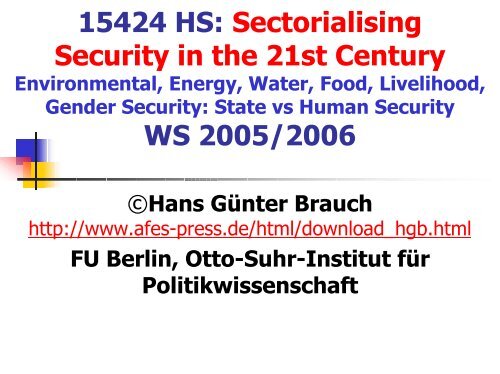
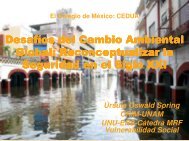
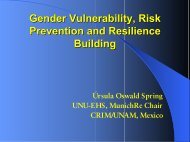
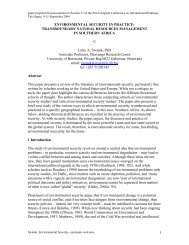
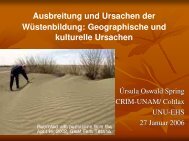

![Environmental security debates in Central Asia [and in Iran]: The ...](https://img.yumpu.com/48908494/1/184x260/environmental-security-debates-in-central-asia-and-in-iran-the-.jpg?quality=85)
